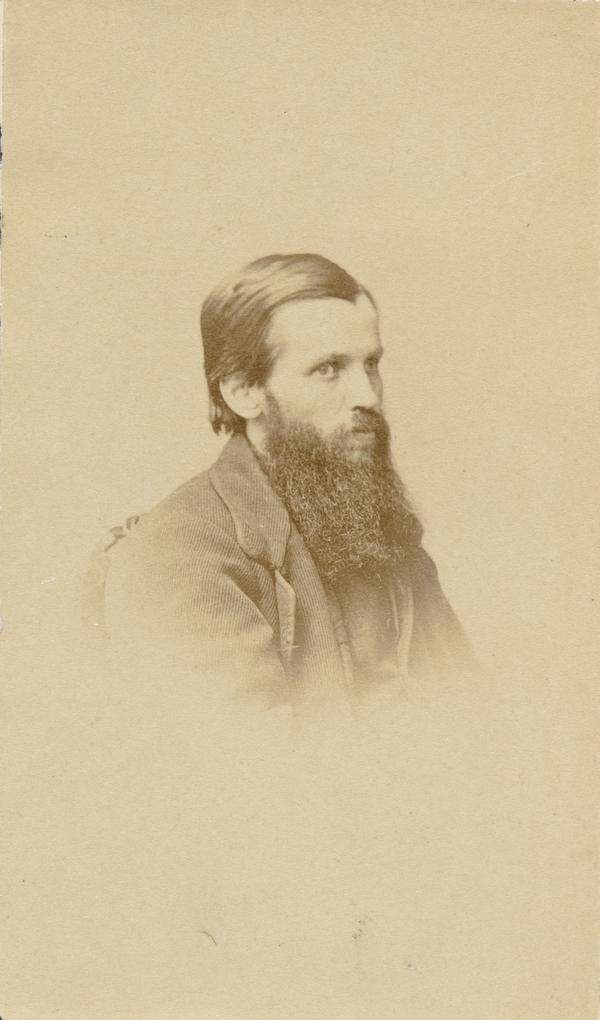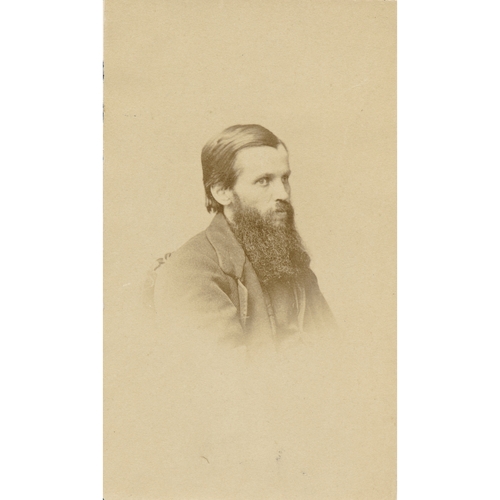
Source: Link
BENOÎT, dit Livernois, JULES-ISAÏE (baptized Isaïe, he sometimes signed Jules-Isaïe Benoît de Livernois, and sometimes J. B. de Livernois), businessman and photographer; b. 22 Oct. 1830 at Longueuil, Lower Canada, son of Amable Benoît, dit Livernois, a farmer, and Desanges Beaudry; m. 9 May 1849 Élise L’Herault, dit L’Heureux, in the parish of Saint-Roch, Quebec City, and they had four daughters and two sons; d. there 11 Oct. 1865.
Jules-Isaïe Benoît, dit Livernois, was a person of feverish activity, energetic, persistent, and venturesome. He seemed to be destined for a rural existence, but quite early left his father’s farm, a discouraging environment ill suited to his spirited temperament. He launched into a series of commercial activities. Taken on as a clerk in a Quebec City business, he then became a store owner in Saint-Zéphirin-de-Courval in 1851. The next year he had a bakery and a large store in Richmond, as well as two other commercial establishments beside the tracks of the Grand Trunk Railway. A victim of unfavourable circumstances, he was betrayed by some of his employees and went bankrupt. In October 1853 he embarked for the United States, hoping to find the wherewithal to repay his creditors. After going round the Americas via Cape Horn, he reached San Francisco, where he succeeded in building “a large steam laundering plant.” His business was prospering when his family suddenly recalled him to Quebec. In a hurry to sell his undertaking, he made it over to his chief employee, who disappeared without paying him after having resold the establishment to a third person. Penniless again, Livernois was obliged to serve as a sailor and to cross the Isthmus of Panama on foot to make his way home. In Panama he contracted a virus that would contribute to his early death a decade later.
At the end of 1854, undaunted by his earlier experiences, Livernois (he was then 24) opened a daguerreotype studio in Quebec City with the help of his wife. At the same time he also went into the sewing machine business and, a few months later, books and stationery — though these ventures proved to be short-lived. Although it was a new art form photography had been well established in the town, and technical developments enabled Livernois to offer photographs printed on paper or tinted with oils, as well as ambrotypes (photographs on glass). He also offered instruction in the art.
During the decade he worked as a professional photographer, Livernois, characteristically, maintained two and sometimes three studios in the city’s Upper Town and the more popular faubourg Saint-Roch. In July 1863 a study trip took him to England, Scotland, and Paris, but “anxiety about his family” soon brought him back home. As his health was steadily deteriorating, his doctors advised him to take treatment at Florence, in the United States. There he hoped to recover, but his health continued to decline. He died in Quebec City on 11 Oct. 1865. Among the friends present at his funeral was Louis-Prudent Vallée*, a well-known Quebec businessman and photographer.
Jules-Isaïe Livernois’s insatiable curiosity prompted him to undertake many diverse activities and led him away from the beaten track. Within his profession he was remarkable, as his contemporary, Henri-Raymond Casgrain*, makes clear: “Photography would have been no more than a trade for him, as for many others, if he had not had the intelligence to enhance its practice by unselfish research. He set out in zealous pursuit of pictures, portraits, views, engravings, and old paintings that might be of interest. In this way he accomplished something of real value by popularizing and preserving precious objects buried in dust and liable to perish. This fine collection, which a short while ago it would have been impossible to obtain, now has its place in the albums of all art lovers.” Thanks to the care taken by Livernois’s descendants, many pages of these albums are extant, and they reveal important aspects of the cultural history of 19th-century Quebec.
Jules-Isaïe’s widow, Élise L’Herault, dit L’Heureux, who played a key role in the development of his business, carried on his work until 1873. Their son Jules-Ernest Livernois*, and later their grandson Jules, followed in their footsteps, enabling the firm that Jules-Isaïe founded to become one of the rare Canadian photography studios that remained in business for a century. It closed its doors in 1979.
[The only study of Jules-Isaïe Benoît, dit Livernois, Jules Livernois by Henri-Raymond Casgrain, was published in Quebec City a year after the photographer’s death. The information it contains, some of it difficult to verify, was probably obtained in interviews with Benoît’s widow. l.h.-m.]
ANQ-M, État civil, Catholiques, Saint-Antoine (Longueuil), 23 oct. 1830. ANQ-Q, État civil, Catholiques, Saint-Roch (Québec), 9 mai 1849, 14 oct. 1865. McLaughlin’s Quebec directory, 1855–58. Quebec directory, 1858–66.
Bibliography for the revised version:
Michel Lessard, Les Livernois, photographes (Québec, 1987).
Cite This Article
Louise Hamel-Minh, “BENOÎT, dit Livernois, JULES-ISAÏE (baptized Isaïe) (Jules-Isaïe Benoît de Livernois, J. B. de Livernois),” in Dictionary of Canadian Biography, vol. 9, University of Toronto/Université Laval, 2003–, accessed March 31, 2025, https://www.biographi.ca/en/bio/benoit_jules_isaie_9E.html.
The citation above shows the format for footnotes and endnotes according to the Chicago manual of style (16th edition). Information to be used in other citation formats:
| Permalink: | https://www.biographi.ca/en/bio/benoit_jules_isaie_9E.html |
| Author of Article: | Louise Hamel-Minh |
| Title of Article: | BENOÎT, dit Livernois, JULES-ISAÏE (baptized Isaïe) (Jules-Isaïe Benoît de Livernois, J. B. de Livernois) |
| Publication Name: | Dictionary of Canadian Biography, vol. 9 |
| Publisher: | University of Toronto/Université Laval |
| Year of publication: | 1976 |
| Year of revision: | 2025 |
| Access Date: | March 31, 2025 |



